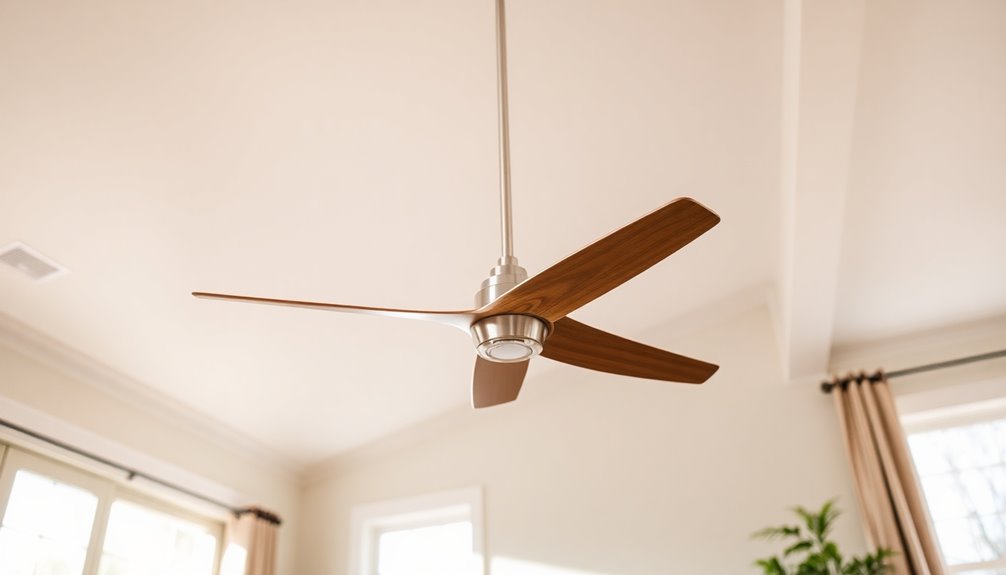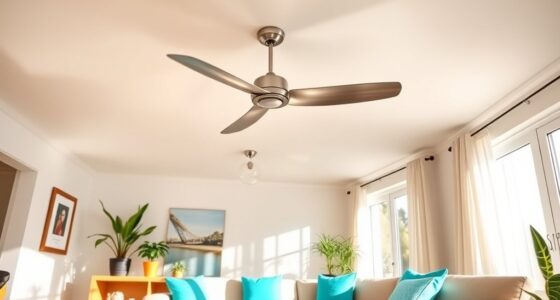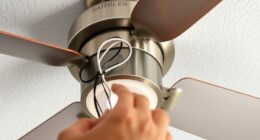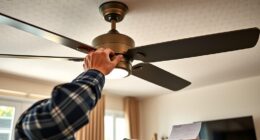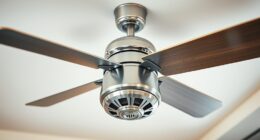The switch on your ceiling fan controls the direction the blades rotate, which impacts your comfort throughout the year. In summer, you can set the fan to rotate counterclockwise to create a rejuvenating downdraft, making the room feel cooler. In winter, switching it to clockwise at a low speed circulates warm air, enhancing heating efficiency. This simple adjustment can save you energy and reduce your bills. Remember to turn off the fan before changing the direction for safety. There's more you can discover about optimizing your fan usage and ensuring it runs efficiently for every season.
Key Takeaways
- The switch on a ceiling fan changes the blade rotation direction for seasonal adjustments.
- In summer, the switch sets the fan to counterclockwise for cooling downdrafts.
- In winter, it adjusts to clockwise for warm air circulation without strong drafts.
- It's important to turn off the fan before changing the switch for safety.
- Some modern fans have remote controls for convenient direction changes.
Understanding Ceiling Fan Switches

Understanding ceiling fan switches is vital for maximizing comfort throughout the year. The ceiling fan switch allows you to change the direction of the blades, which plays an important role in managing air movement for both cooling and heating.
In the summer, you'll want to set the switch to counterclockwise. This direction creates a downdraft, generating a cooling breeze that enhances comfort and can save energy by reducing cooling costs by up to 30%.
When winter rolls around, it's time to flip that switch to clockwise. This change in direction generates an updraft, redistributing warm air from the ceiling back into your living space. This is an effective way to maintain warmth and improve heating efficiency.
Most modern ceiling fans come equipped with a visible switch on the fan body or a remote control option, making it easy for you to operate. Additionally, utilizing modern Energy Star certified fans can further enhance energy savings and comfort year-round.
Just remember, it's important to turn off the fan before changing the direction to guarantee safety and effective operation.
How Blade Direction Affects Comfort

The direction your ceiling fan blades rotate can greatly impact your comfort year-round.
In summer, setting your ceiling fan direction to counterclockwise creates a downdraft, which generates cool air and produces a revitalizing breeze. This wind chill effect enhances your comfort, allowing you to enjoy a cooler environment without needing to lower your thermostat settings, making it more energy efficient.
In winter, you'll want to switch the fan to rotate clockwise at a low speed.
This blade direction creates an updraft that helps move warm air, which often gets trapped near the ceiling, back down into your living space. By redistributing this warm air, you can keep your room cozy while reducing heating costs by as much as 15%.
Summer Settings for Ceiling Fans

To maximize your comfort during the hot summer months, setting your ceiling fan to rotate counterclockwise is key. This direction creates a cooling downdraft that enhances comfort by producing a revitalizing wind chill effect.
When you run the fan at high speed, you can even raise your thermostat settings by up to 4°F without sacrificing comfort. This simple adjustment not only keeps you cool but can also considerably reduce your energy costs—up to 30%—by decreasing your reliance on air conditioning.
To change the ceiling fan's direction, locate the switch on the motor; it's usually easy to find and adjust. Once you've switched it to counterclockwise, stand under the fan to confirm it's working correctly.
You'll feel the cool air rushing down, indicating that you've achieved the ideal ceiling fan direction for summer. Embracing this setting during the warmer months won't only keep your space comfortable but also make a positive impact on your energy bills. Additionally, regular maintenance of your ceiling fan can help prevent issues like a clicking noise that could arise from mechanical failures.
Winter Settings for Ceiling Fans

Setting your ceiling fan to rotate clockwise in winter can make a remarkable difference in your home's comfort. When your ceiling fan spins in this direction at a low speed, it creates a gentle updraft that helps redistribute warm air trapped near the ceiling.
This clockwise rotation guarantees that warm air circulates down into your living space, improving heating efficiency and maintaining a consistent temperature throughout the room.
To check if your fan is spinning clockwise, simply stand underneath it and feel for the absence of a strong draft; this indicates that air is being pulled upward. By adjusting your fan to the correct direction for winter, you can greatly enhance the effectiveness of your heating system.
Not only does this promote a more comfortable environment, but it can also lead to impressive energy savings. Many homeowners experience reductions in utility bills of 15% or more, allowing for lower thermostat settings without sacrificing comfort.
Incorporating this simple adjustment into your winter routine can truly elevate your indoor experience while maximizing your heating resources.
Energy Savings From Proper Use

Maximizing energy savings with your ceiling fan is easier than you might think. By simply using the direction switch, you can notably reduce your cooling and heating costs throughout the year. In summer, set your fan to create a cooling downdraft, which can save you up to 30% on cooling costs. Conversely, in winter, switch it to clockwise to redistribute warm air and cut heating bills by up to 15%.
Here's a quick overview of how adjusting your ceiling fan can enhance your energy savings:
| Season | Fan Direction | Potential Savings |
|---|---|---|
| Summer | Counterclockwise | Up to 30% on cooling costs |
| Winter | Clockwise | Up to 15% on heating costs |
| Year-round | Varies | Raise thermostat by 4°F |
| Pairing | ENERGY STAR unit | Up to 8% more efficiency |
| Airflow | Optimized | Comfort maintained year-round |
Ceiling Fan Direction in Different Rooms

When it comes to ceiling fan direction, different rooms require specific settings for ideal comfort.
In vaulted ceilings, you'll want to keep the fan running counterclockwise to circulate air effectively.
Meanwhile, dining rooms and home offices benefit from adjusting the fan to clockwise, helping create a pleasant atmosphere without disrupting your activities.
Vaulted Ceiling Considerations
In rooms with vaulted ceilings, understanding how to position your ceiling fan can greatly enhance airflow and comfort. To maximize air movement, keep your fan running counterclockwise year-round. This setting helps minimize wind chill while guaranteeing proper air circulation throughout the space.
When installing a ceiling fan in a vaulted ceiling, consider the following guidelines:
| Aspect | Recommendation |
|---|---|
| Fan Height | Hang the fan 7-9 feet from the floor for maximum airflow. |
| Clearance from Ceiling | Maintain 10-12 inches between the blades and the ceiling to avoid obstruction. |
| Distance from Walls | Guarantee at least 18 inches of clearance from walls for effective air movement. |
You might need a down rod to achieve the right fan height and angle, particularly in rooms with steeply pitched ceilings. This will enhance performance and comfort. By following these considerations, you'll create a pleasant atmosphere in your vaulted ceiling spaces, making the most of your ceiling fan's capabilities.
Dining Room Settings
Installing a ceiling fan in your dining room can greatly improve comfort during meals. To create a comfortable atmosphere, set your ceiling fan to rotate clockwise at a medium or low speed. This direction generates a gentle updraft, distributing warm air evenly and guaranteeing your dining experience remains cozy without cooling your food too quickly.
Using the fan in the clockwise direction also helps prevent papers and table settings from blowing around, making your dining area more conducive for gatherings.
If your dining room features a vaulted ceiling, it's best to keep the fan on clockwise year-round. This minimizes wind chill effects that could disrupt your meals, allowing you and your guests to focus on enjoying the food and company.
For ideal comfort, verify your fan is mounted at the right height—ideally 7-9 feet from the floor. This height effectively circulates air while avoiding an uncomfortable breeze.
Home Office Functionality
A ceiling fan can greatly enhance your home office's functionality by contributing to a comfortable and efficient workspace.
To create that ideal environment, it's crucial to change your ceiling fans' direction with the seasons. In the summer, set the fan to rotate counterclockwise. This creates a cooling breeze that keeps you focused and productive.
Conversely, in winter, switch it to clockwise at a medium speed. This prevents papers from blowing around while generating a gentle updraft that helps distribute warm air evenly. Additionally, maintaining a comfortable temperature is essential for remote work productivity, as it allows you to stay focused and energized throughout the day.
Tips for Changing Fan Direction

Changing the direction of your ceiling fan can greatly enhance comfort throughout the year. To get started, remember to turn off the fan and let it come to a complete stop before using the switch to change the direction.
You'll want to set your ceiling fans to spin counterclockwise during the summer months. This creates a revitalizing downdraft that helps cool your living space, making those hot days feel more bearable.
As winter approaches, switch the fan to rotate clockwise. This will push the warm air that rises back down into the room, improving overall warmth and comfort. A great time to make these adjustments is during Daylight Savings Time changes, as it coincides with seasonal temperature shifts.
Don't forget to regularly check the functionality of the switch to verify your fans operate correctly in the desired direction. This not only maximizes comfort but also contributes to energy savings.
Importance of Blade Angle

Understanding the importance of blade angle is vital for enhancing your ceiling fan's performance. The angle of the blades directly impacts airflow and cooling efficiency. Ideally, a blade angle should be set at a minimum of 12 degrees to maximize airflow. This guarantees that your ceiling fan effectively circulates air, enhancing comfort in your space.
If the blade angle exceeds 16 degrees, it may disrupt airflow, creating turbulence that could affect loose objects in the room. This is especially relevant in larger spaces where multiple fans might be necessary for ideal air circulation.
By maintaining the proper blade angle, you not only improve airflow but also enjoy significant energy savings. A well-adjusted ceiling fan reduces the need for air conditioning, allowing you to maintain a comfortable temperature without relying excessively on energy-hungry systems.
Regularly checking and adjusting your fan's blade angle is essential for maintaining fan performance. This simple step can guarantee your ceiling fan operates efficiently throughout its lifespan, providing you with both comfort and cost savings.
Maintenance for Optimal Performance

To keep your ceiling fan running smoothly, regular maintenance is key. By following these simple steps, you can enhance performance and energy efficiency while guaranteeing your fan operates safely:
- Clean the Blades and Motor: Regularly dusting and cleaning the blades and motor can greatly improve airflow efficiency and reduce energy consumption.
- Check the Direction Switch: Periodically inspect the functionality of the switch to confirm it operates correctly for seasonal adjustments. This will help maintain peak performance throughout the year.
- Tighten Screws and Bolts: Verify that the ceiling fan is securely mounted, and all screws and bolts are tightened. This prevents wobbling and enhances safety during operation.
- Listen for Unusual Noises: Inspect the fan for any strange noises or vibrations. These could indicate maintenance needs or the need for repairs, so addressing them promptly can extend your ceiling fan's lifespan.
Frequently Asked Questions
Should the Fan Switch Be up or Down?
When you're deciding whether the fan switch should be up or down, think about the season.
If it's summer, you'll want the switch in the up position to make the blades spin counterclockwise, creating a cool downdraft.
In winter, switch it down for a clockwise rotation, which helps circulate warm air trapped near the ceiling.
Adjust the switch accordingly to maximize your comfort and energy efficiency throughout the year!
What Does Flipping the Switch on a Ceiling Fan Do?
Flipping the switch on your ceiling fan changes its spin direction, which affects how air moves in your room.
When you set it to counterclockwise, it pushes cool air down, perfect for hot summer days.
In winter, switch it to clockwise to pull warm air from the ceiling and circulate it back down.
This simple adjustment can help you stay comfortable and may even save you money on heating and cooling costs.
What Is the Little Switch on My Fan For?
The little switch on your fan controls the direction of the blades. When you flip it, you can choose whether the blades spin clockwise or counterclockwise.
In summer, setting it to counterclockwise creates an invigorating downdraft, cooling your space. In winter, switching it to clockwise helps circulate warm air from the ceiling, keeping your room cozy.
Adjusting this switch seasonally can make your home more comfortable and save on energy costs.
How Do I Know if My Fan Is in Summer Mode?
Checking if your fan's in summer mode is as easy as feeling a gentle breeze on a hot day.
Look up and see if it's spinning counterclockwise; that's the key for creating a cooling downdraft.
Stand directly beneath it and feel the rush of air to confirm it's working properly.
If you notice little airflow, it mightn't be set correctly or there could be an issue with the motor.
Conclusion
In the dance of seasons, your ceiling fan becomes an ally, swirling cool breezes in summer and warm whispers in winter. Just like a gentle breeze rustles leaves, adjusting that switch can transform your comfort. Picture yourself sipping lemonade as a invigorating gust sweeps through, or cozying up with a blanket as warm air envelops you. By mastering your fan's direction, you're not just saving energy—you're creating the perfect atmosphere in every room, no matter the season.



